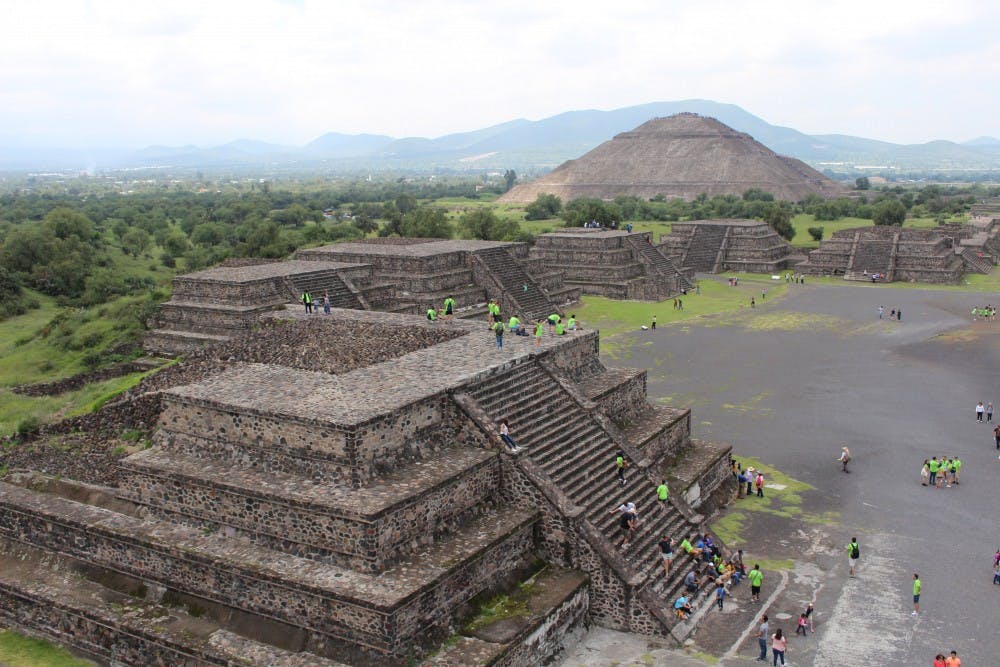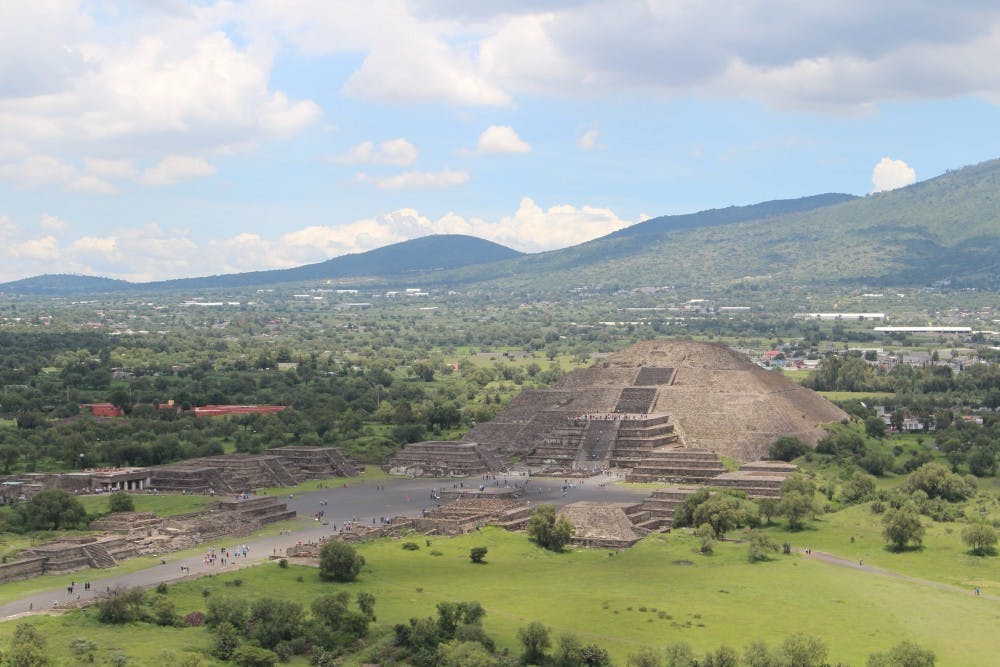Everyone in Teotihuacan gathers to watch the sacrifices. Thousands flock the wide stone boulevard, leading up to the base of the towering Pyramid of the Moon, the second highest temple in the city, which stands well above the rest of the city’s stone abodes.
There was a time when those who were given to the gods came from far away cities at war with Teotihuacan. If a Teotihuacano were to be sacrificed, he would always be proud to be of service, to repay the debt owed. But that time is no longer. The neighborhoods of the city have become more divided. The ethnic minorities face the most oppression from the rulers, who have become dissatisfied that the crops are not producing and that more people are leaving the city due to the drought.
Tonight, no one looks forward to the sacrifice, except some of the more powerful Teotihuacanos. The rest of the city, which works the fields and sees the drought with its own eyes, doesn’t want to see anyone else die. There is no honor in these deaths recently. It is clear the Maya and other minorities are being killed because the nobles don’t want to see their own brothers and children be cut down at the steps. They used to offer them willingly, but in these harsh times, it is too much of a burden to lose family in the service of the debt to the gods.
If they think the gods do not realize this hypocrisy, then their arrogance has gone too far. The sacrifices will not be accepted. The debt persists. The farmers and low craftsmen – whether they be the Teotihuacano, the Maya, the Mixtec, the Otomi – no matter their ethnicity, they all see through the façade of a struggling ruling class, one that feels threatened by drought and whispers of mutiny echoing off the stone walls and expansive streets of the city, right up into the high temples that look down on the treetops and plains.
The priest leading tonight’s sacrifice says something like, “Noble citizens, our debt for sustenance is paid through the spilling of your blood tonight.” The Macuahuitl falls, the heads roll. Blood pours down the craggy stone steps, reflecting in the glistening torched eyes of a resentful mass. Teotihuacan used to be the pride of the world. Teotihuacano leaders took over far-away Mayan cities. Teotihuacan fashion and art were appropriated by every people that knew of them and their glory. Teotihuacan owned most of the roads in the region, extracting tolls and taxes from adjacent peoples. In the city itself, the under-laborers – farmers, craftsmen, warriors, artists – all cohabitated this city happily with the noble classes, which were then not so distant from the people. But towers have been built higher.
This night, a mass is gathering in one of Teotihuacan’s neighborhoods. Young men run through the corridors connecting the web of raised stone apartments; they are delivering messages and persuading friends to join them. The men killed tonight were all of a single family from one of the larger ethnic minority neighborhoods in the city. But this family has weight here. In fact, they are well-respected. The angry growing mass has conspired to march toward the city center, forever changing the course of Mesoamerican history.
Hundreds of years before the term ‘revolution’ came to mean anything in the West, a resentful mass of Teotihuacanos, probably led by some insurgent faction, burned and likely murdered much of the ruling theocratic class. This is thought to be the hard-stop end of the era in which Teotihuacan dominated the mid-region of Mexico (surpassing even the Maya in influence and economic primacy) during the fifth and sixth centuries C.E. Or so the story goes.
It’s not certain that history happened the way I’ve described above, and we certainly don’t know the specifics, but the end of Teotihuacan must’ve been a dramatic affair. Most of us are acquainted with the ancient intrigue of Cleopatra and Antony, or maybe some compelling old biblical drama. But little is brought into popular culture as far as ancient Mesoamerican history is concerned, aside from Mayan visions of the apocalypse and movies about the Spanish conquistadores.
There’s a reason for that, actually. There is debated evidence for a glyphic writing system, but there is no extant written record by the Teotihuacan people. In the case of Teotihuacan, everything we know is inferred from Aztec commentary, usually from hundreds of years after the fact, or archaeological evidence. The latter is how much of the story is being filled in today, and many archaeologists now think Teotihuacan fell to an internal rebellion.
A millennium and a half after the demise of Teotihuacan, I sat down to speak with ASU archaeologist and Director of the ASU Teotihuacan Research Laboratory Michael Smith, who told me this is now one of the foremost theories in the field. Many archaeologists used to believe (and many still do) that a northern people, fleeing drought, moved down into the low Valley of Mexico, in the present-day State of Mexico, and invaded Teotihuacan, torching the city in the process. But recent work has shown that the only buildings burned were administrative – those belonging to the ruling religious-political class. Naturally, this leads to the question of why only those buildings were burned.
As Smith puts it, “If people were very prosperous and things were going well economically, then when conditions got worse because of drought and lower agricultural yields, people got fed up and blamed the rulers, priests.”
Angela Huster, a post-doctoral researcher working with Smith on the Teotihuacan project, says one way to speculate about what happened at Teotihuacan is to combine the invasion and rebellion theories.
“There were these immigrants coming in; they were trying to be integrated into the fabric of the city,” Huster says. “And maybe it wasn’t working or it was putting stress on the city’s ability to provide for its residents, so then everybody became unhappy as stuff got more stretched.”
Regardless of how exactly Teotihuacan found its end, the city lived on hundreds of years later through Aztec myths, and, eventually, the Spanish invaders, who wrote copiously (and often inaccurately) about the city. Today, it is university anthropologists who create and preserve knowledge pertaining to this great, ancient people. Foremost in that endeavor today is ASU and the team of researchers led by Michael Smith.
Despite the fact that Teotihuacan may have fallen to a rebellion, the fact remains that the city was one of the most egalitarian societies in the world for much of its existence, according to Smith. This finding has astounded anthropologists and motivates one of the biggest research programs on Teotihuacan today. Furthermore, it leads to even more questions about why the Teotihuacan people would have rebelled. This is the problem that interests Smith.
"How does this society work?" Smith asks. "Were they really that much more prosperous than everyone else? Were they really that much more egalitarian? For me, that's the crucial thing at Teo. How was this society organized? How did they do it?"
For more information on ASU’s research of Teotihuacan, click here.
Editor's note: The story told at the beginning of this article does not reflect the professional opinion of Professor Michael Smith or any other researcher in the field. It is fictional and reflects only the informed imagination of the author.
Reach the reporter at parkermshea97@gmail.com or follow @laconicshamanic on Twitter.
Like The State Press on Facebook and follow @statepress on Twitter.






